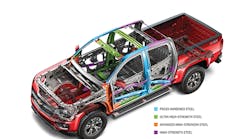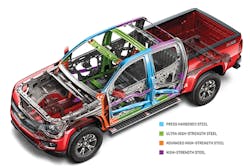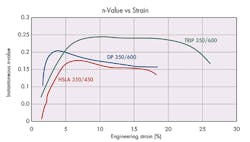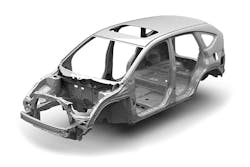This file type includes high resolution graphics and schematics when applicable.
Engineers wrangling with material technology continuously try to find the right balance of properties. However, it’s safe to say that two properties have remained constant over the years—stronger and lighter.
Around the end of the last millennium, tighter regulations caused the automotive industry to look for new ways to reduce the energy associated with making and operating vehicles. The challenge became greater when stricter safety regulations arrived around the same time. Beyond that, car manufacturers need to satisfy customer demand for a cost-effective vehicle, both in sticker price and operation cost, which makes navigating this capital-intensive industry an interesting venture even for big corporations (see "Capital-Heavy Changes" at the end of the article).
Lower-Density Metal
Passenger vehicles are estimated to cut an average of 640 lb from their total weight between 2010 and 2020 by using different materials. This may not sound like much, but it’s happening despite increasing safety regulations. For example, about 20 years ago, the roof strength requirement to resist roll-over crush was roughly the weight of the vehicle. Today, roll-over strength is about four times the gross vehicle weight.
Experts say that to make things lighter, also known as lightweighting, engineers must find materials less dense than steel, such as aluminum. However, change isn’t easy for an industry the size of the automotive market.
For example, aluminum’s lower modulus of elasticity compared with steel requires the use of a thicker sheet to maintain equal stiffness with the same part shape. On the other hand, a more complex part shape can be used to increase stiffness, but challenges arise when forming complex part shapes out of aluminum. The forming process would have to be adjusted and redesigned to accommodate aluminum parts. Also, aluminum takes more materials to equal the same strength as steel. On top of that, stamping machines would need be adjusted and redesigned for the larger aluminum parts.
“It could cost hundreds of thousands to around one million dollars to update one new die line up for the stamping of automotive body panels,” said Danny Schaeffler, President of Engineering Quality Solutions. “A car’s sheet-metal body can have about 250 parts, so adjusting to a new material is a major investment. After the economic downturn about seven years ago, Ford made a significant capital expenditure of over a billion dollars to convert their Dearborn, Michigan complex so that it could convert its steel F-150 to one that is mostly aluminum.”
Learn about lightweight, low-cost steel used in the frame of a Ford Vehicle in the following video on Engineering TV:
Cost is a key factor with lower-density metals, as researchers look for ways to cut down the overall price tag. According to a report from Gossan Resources Ltd., if the cost of magnesium (Mg) could drop to around 1.3 times the cost of aluminum, it will likely gain larger market shares. Researchers at the Pacific Northwest National Laboratory (PNNL) have such a goal in mind, taking part in a $2.7 million dollar project that kicked off last year to test a new approach to extracting magnesium from seawater.
“Currently, we have proven in the lab every step necessary to produce magnesium and its alloys from seawater,” said Pete McGrail, a Fellow from PNNL. “But a successful pilot demonstration is a critical next step to commercialization. It’s is just too big a jump to go straight to commercial operations.”
Seawater contains about 1.3 kg/m3of Mg that can be extracted with electrolysis. PNNL uses a new organometallic chemical route that saves 40% in energy versus current methods. Magnesium chloride (MgCl2) can be found in seawater, nickel mining, drying lake beds, etc., but the compound is always hydrated. Therefore, the first step is to dehydrate it, which is normally done by heating the MgCl2 to about 1652ËF.
With PNNL’s new process, the temperature is reduced by a third using a dehydration reaction facilitated by ammonia. Then an organometallic process is able to produce a powder, or an ingot form of Mg via hot pressing. That powder is ready to process directly into alloys, eliminating the energy required for milling ingots into a powder first. If the process is perfected and commercialized, PNNL believes Mg could be made for $0.68/lb ($1.50/kg). using 25 kilowatt-hours (kWh) of energy. Currently, China uses the Pidgeon process, a silicothermic reduction, to make the metal, and it requires 102 kWh per kg of Mg.
To avoid the cost of higher-priced metals and retooling, the automotive industry is continually looking for stronger steels that will work with current production lines. Many alloys can increase strength, but this would alter the metals’ formability properties, causing them to crack when being stamped into the desired part shapes. These challenges have already led to several grades of new steels. “About half the steel in cars being used today didn’t exist 15 to 20 years ago,” said Dave Paratore, President and CEO for NanoSteel.
Stronger Steels
The first generation of advanced high-strength steels (AHSS) expanded performance properties so that thinner-gage sheeting could be used for vehicles, but it also reduced formability and thereby limited part designs. The second generation was an attempt at making strong steels more ductile, but these steels weren’t able to be used commercially. This could be why the auto industry pushed for a third generation, which aims to combine strength and ductility while maintaining lower costs and commercial viability.
Strength and elongation—not density—is changed in AHSS. With the increase in strength, less material is required for the same parts. AHSS is more expensive than normal steels, but using less helps offset the cost. The reduction in materials also cuts down on the amount of energy that goes into making a car, which helps companies maintain a “green” image. In areas such as British Columbia, Australia, and others that have carbon taxes, lightweighting can increase company profit by reducing these emission taxes.
Learn about ultra-light steel in the following video on Engineering TV:
Metallurgists are experimenting to find or develop metals that are both malleable and strong to create lightweight parts. Some of the first to emerge combined small quantities of many alloys into a fine dispersion of carbides that can form into an almost pure ferrite matrix. Called high-strength low-alloy steel (HSLA), this metal maintains formability by reducing the steel’s normal volume fraction of pearlite (a hard and brittle mixture of ferrite and cementite formed when cast iron or steel cools), and increases strength thanks to finer grain size. But making the new metal requires 20 to 30% more power than carbon-steel production.
Harder metals that require more processing power becomes a problem when it comes to the scale of the automotive industry. “The cycle time for a large auto company is around 750,000 trucks a year—that’s about one truck per minute,” said Engineering Quality Solutions’ Schaeffler “An F-150 body could have hundreds of parts. If ductility of a material increases cycle time, meeting production quotas on schedule might be impossible.”
“For decades, steel has been made in 150- to 200-ton batches while controlling the constituents by the parts-per-million,” explained NanoSteel’s Paratore. This allowed development of many types of steels. One version, called dual-phase (DP) steel, is a hard but brittle martensite that’s surrounded by softer, more ductile ferrite. This steel has the strength and malleability that works well for crumple zones and parts requiring more complex geometry. Unlike aluminum and HSLA, DP can increase its strength by up to 70% by work hardening and bake processing.
With so many grades of AHSS, a simplified root-cause analysis of what’s trying to be accomplished would be the attempt to increase the processing window between the yield and tensile strength of new materials. On a stress strain graph, the distance and slope between the yield and tensile strength are important. The slope of the log strain versus log stress is called the n-value. A steeper slope, or higher n-value, indicates a material’s ability to displace stress across the material and elongate more before necking. This leads to better sheet-metal formability, which is a critical factor for stamping.
The higher n-value means that it can absorb more energy without necking or failing. For the automotive industry, a material’s sheet-metal formability with a higher n-value can lead to improved crash and impact performance.
Determining the metal that works best always depends on the application. Transformation induced plasticity (TRIP) maintains its work-hardening rates despite increases in strain. This makes TRIP steels work well for frame rails. Another property to consider is the fatigue strength. Steels can be designed to offer an endurance limit, which isn’t the case with aluminum. This makes steel a better choice for parts that will experience high cycle and dynamic loads. Fatigue failures can also be caused by corrosion. If oxidation resistance is a concern, aluminum might work better than steel. Other concerns surround the metal’s ability to be used in different processes.
Robotically welding aluminum led to early failures that initially made welding aluminum a risky or difficult label. This may affect materials selection for components that require welding. Materials and processing may sound basic, but are all-important when designing and selecting materials. Another key factor when designing with dissimilar metal is to properly insulate joints, or an acidic rain may turn these new cars into a giant battery. The success of future vehicles may boil down to which company hires the engineers who retain the most information from their freshman “Materials and Processes” class and grow that knowledge in the field.
Steel and Nanotechnology
Demand for cost-effective steel in the automotive industry has a certain group of engineers turning to nanotechnology, leading to some interesting results. To make a nanomaterial available for the automotive industry scale is important. NanoSteel, based in Providence, R.I., uses a novel recipe and thermochemistry to bulk-produce a new type of steel that contains nanoscale microstructures.
NanoSteel can deliver unique combinations of strength and ductility that come from the discovery of enabling mechanisms that are able to create nanoscale structures while using the existing processes in a modern steel plant, including casting, hot rolling, and then cold rolling. The company uses conventional steel alloying elements, but in novel ratios to create the enabling structures. These structures then dictate the resulting properties. The end result is stronger, formable steel that’s designed to be used in today’s automotive plants.
A study by independent engineering firm EDAG Inc. compared different material combinations to make the body for a 2011 Honda Accord. The main non-moving parts of a vehicle’s structure are collectively known as the body in white (BIW), and much of the focus concerns lightweighting. Using NanoSteel’s AHSS reduced the BIW’s mass by 30%. The increased cost of using the NanoSteel alloys has not yet been released, but it’s estimated to be modest due to the ability to leverage both existing steel manufacturing facilities as well as existing automotive parts manufacturing.
This result is comparable to a similar earlier study by EDAG for the U.S. National Highway Traffic Safety Administration (NHTSA), which used a number of lightweighting scenarios (not NanoSteel alloys). This earlier mix of AHSS, aluminum, and composites saved 24.5% in weight and added about $176 in incremental cost for the whole BIW. For an aluminum-intensive BIW, the weight fell by 35%, but costs climbed to a total incremental cost per BIW of $720. Only focusing on mass reduction enabled composites to reduce weight by 50%, but increased materials costs by $2,500 for the BIW.
Such a cost difference is why only high-performance cars use large amounts of composites, while production vehicles still favor lower-cost materials. Vehicle manufacturers balance the cost-to-weight reductions carefully to maintain competitive costs, fuel efficiency, and safety to meet all national and international regulations
Sidebar: Capital-Heavy Changes
A chicken-and-the-egg problem must be reconciled before the steel and automotive industries can upgrade to new materials. The steel industry wants to upgrade and provide AHSS, but only if they first have orders in hand. Meanwhile, the automotive industry requires that steel companies be able to produce the necessary metals in volume before placing orders.
This file type includes high resolution graphics and schematics when applicable.
Both sides have made steps toward a solution, though. Ford, for example, invested $1 billion in its Dearborn Stamping and Assembly plants to make the new aluminum-intensive F-150. And U.S. Steel invested $500 million to upgrade production to make different types of AHSS steels.
“Mass production was a key driver for the investments,” said Danny Schaeffler, President of Engineering Quality Solutions. “Just think of the volumes necessary to justify the $500 million investment into a production line for a product that sells for $1 per pound.”





